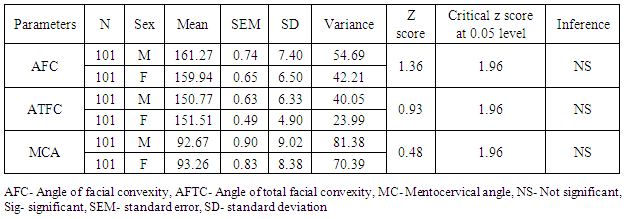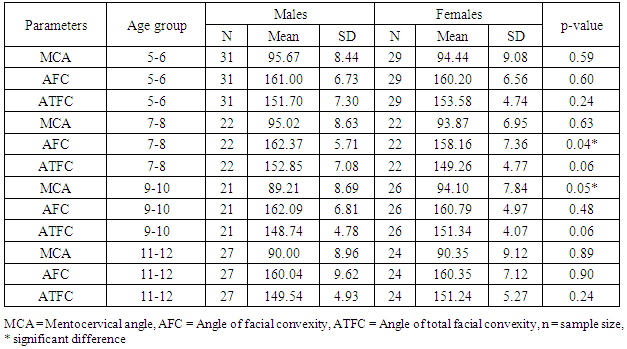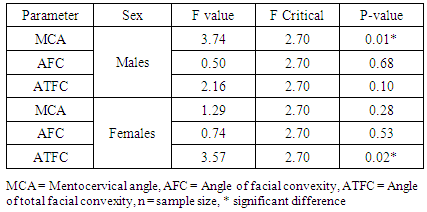-
Paper Information
- Paper Submission
-
Journal Information
- About This Journal
- Editorial Board
- Current Issue
- Archive
- Author Guidelines
- Contact Us
American Journal of Medicine and Medical Sciences
p-ISSN: 2165-901X e-ISSN: 2165-9036
2018; 8(2): 21-24
doi:10.5923/j.ajmms.20180802.01

Facial Soft Tissue Profile Ikwerre Children between 5 to 12 Years
Loveday E. Oghenemavwe1, Clinton D. Orupabo2, Kingsley M. Azuh1
1Department of Anatomy, Faculty of Basic Medical Sciences, College of Health Sciences, University of Port Harcourt, Choba, Nigeria
2Department of Anatomy, Faculty of Basic Medical Sciences, College of Medicine, Rivers State University, Nkpolu-Oroworukwo, Nigeria
Correspondence to: Loveday E. Oghenemavwe, Department of Anatomy, Faculty of Basic Medical Sciences, College of Health Sciences, University of Port Harcourt, Choba, Nigeria.
| Email: |  |
Copyright © 2018 Scientific & Academic Publishing. All Rights Reserved.
This work is licensed under the Creative Commons Attribution International License (CC BY).
http://creativecommons.org/licenses/by/4.0/

The aim of the study is to quantify the facial soft tissue profile of Ikwerre children between the ages of 5 and 12 in a population sample of 202 persons (101 males and 101 females) randomly selected from various Children Centre in Port Harcourt. Standard photographic measurements were taken in the natural head position to determine the mentocervical angle (MCA), angle of facial convexity (AFC) and angle of total facial convexity (ATFC). The data obtained were tested with z test, student t test and Anova at 0.05 statistical significant levels. The mean value for the MCA for boys and girls were 92.67 degrees and 93.26 degrees respectively; AFC was 161.27 degrees for boys and 159.94 degrees for girls; ATFC for boys and girls were 150.77 degrees and 151.51 degrees respectively. The mean MCA for the lowest age group studied (5 – 6 years) was 95.67 degrees for boys and 94.44 degrees for girls whereas that for the highest age group (11 – 12 years) was 90 degrees for boys and 90.35 degrees for girls. There was no significant difference (p>0.05) in the mean for boys and girls irrespective of age. AFC in children between 7-8 years and MCA in children between 9-10 years showed significant statistical difference (p<0.05) in the mean for boys and girls. Comparison amongst the age groups showed that MCA in boys and ATFC in girls showed significant (p<0.05) variations. In conclusion, the lower jaw of Ikwerre children is slightly retrusive, AFC in children between 7-8 years and MCA in children of 9-10 years showed sexual dimorphism. The data will be useful to medical specialty involved in the treatment of the face as well biomedical anthropologist.
Keywords: Ikwerre, Facial profile, Soft tissue
Cite this paper: Loveday E. Oghenemavwe, Clinton D. Orupabo, Kingsley M. Azuh, Facial Soft Tissue Profile Ikwerre Children between 5 to 12 Years, American Journal of Medicine and Medical Sciences, Vol. 8 No. 2, 2018, pp. 21-24. doi: 10.5923/j.ajmms.20180802.01.
1. Introduction
- The Ikwerre tribe is one of the largest ethnic groups in Niger delta region of Nigeria having a major stake in the economic and political roles of the region. They are predominantly farmers, and also take up fishing being the major occupation of its environs. They occupy a major landscape of the region. [1, 2] The face is the anterior aspect of the head and occupies in the longitudinal direction from the hairline of the forehead to the chin and from the right to the left ear transversely. The face carries very important structures which include the eyes, the nose, the mouth and the ears. It defines the identity and appearance of any individual. [3] Hence obvious changes in the anatomy of the face could be quite remarkable as to changing ones outward look. The basic shape of the face however is determined by the underlying bones, though the soft tissues determine primarily the aesthetics and appreciation of an individual. The individuality of the face results from anatomical differences: variations in shape and relative prominence of the features of the underlying cranium, fat deposition, effects of aging and skin colour as well as hair distribution. Other factors that could contribute to facial variations include nutrition, health related issues including old facial scars from road traffic accidents and facial surgeries. Facial soft tissues could vary with age and sex following muscular and skeletal development. As a child advances in age, it is expected that the body proportions including the face would change proportionately except where alterations are caused by natural and acquired conditions. [4, 5]Previous studies on facial dimensions have been able to elaborate what could be obtainable from different groups on a wider scale. For instance, Oladipo et al. [6] measured the craniofacial dimensions of Ijaw children and adolescents in Nigeria with normal facial morphology using some parameters like; nasal height, maxillary height, mandibular height, orofacial, facial and head circumference and established that males had significantly higher values than females for all parameters. Akpa et al. [7] established in a study of the Igbos that nasal heights for both male and female were 6.31cm and 6.04cm respectively. A study by Subtenly, [8, 9] on the soft tissue facial structures and their profile characteristics of subjects between 3months to 18years showed that some soft tissue profile follows proportionately skeletal growth with age. Torlakovic et al. [10] reported on the age-related changes of the soft tissue profile from the second to fourth decades of life and established that significant changes occurred in the soft tissue facial profile from the second to the fourth decades, and that aging of the male facial profile began 10 years later than for the females; however, when the changes did occur, they were of greater magnitude. Photographic facial soft tissue analysis of adolescent Persian population by means of linear and angular measurements showed that the labial, nasal and chin areas are sexually dimorphic with males having greater facial heights, larger faces, and longer nasal, labial and chin lengths. Sandra et al. [12] analyzed the soft tissue facial profile of 110 dental students of University of Zagreb, Croatia and reported that all angles were larger in females. While there are studies of the facial soft tissue profile of adults in many ethnic groups in Nigeria that for children are very rare. This study seeks to quantify the facial soft tissue profile of Ikwerre children between the ages of 5-12 years using angular dimensions.
2. Materials and Methods
- The sample size for this study consisted of 202 children (101 males and 101 females) from Ikwerre extraction between the ages of 5-12 years, who were randomly selected from Children Centres in Port Harcourt. The parents and 4 grandparents of the children were from Ikwerre ethnic group. Written informed consents were obtained from parents/guardians and children who were able to read and write. The volunteers had aesthetic pleasing face as adjudged by two persons, no craniofacial deformities and any history suggesting a previous orthodontic treatment or rhinoplasty. Questionnaires and verbal interview were used to obtain information such as; sex, age and ethnicity of the parents and medical history. The photographs were taken and analyzed with Pro-image software as reported in our earlier studies. [13-15] Facial dimensions measured were mentocervical angle (MCA) which is a vertical line tangent to the forehead running through the glabella and pogonion, and intersecting a second line tangent to the menton; the angle of total facial convexity (ATFC), which is the angle formed at the intersection of two lines drawn from the glabella to the pronasale, and then to the gnathion; and the angle of facial convexity (AFC), which is formed between the glabella, subnasale and gnathion. The data were analyzed for descriptive statistics, paired t test was used to evaluate reliability of measurements, Z and independent t tests were used to evaluate the differences in mean of males and females, while Anova test was used to determine variation among the age groups.
3. Results
- The intra-observer variation in measurement were in strong agreement as revealed by statistical insignificant (p>0.005) differences in the mean. Table 1 shows the mean angular dimensions of the soft tissue facial profile irrespective of age group. There was no significant difference (p>0.05) in the mean of boys and girls. There was a decrease in AFC (160.04 degrees) in children between the ages of 11-12. AFC in children between 7-8 years and MCA in children of 9-10 years showed significant statistical difference (p<0.05) in the mean for boys and girls (see table 2). Among the age groups, MCA in males and ATFC in females showed significant (p<0.05) variations (see table 3).
|
|
|
4. Discussion
- This study investigated the facial soft tissue profile of Ikwerre children between 5 -12 years using the angle of facial convexity, the angle of total facial convexity and the mentocervical angle using standard photogrammetric recordings in the natural head position.The mean value recorded in this study for MCA for males and females were 92.67 and 93.26 degrees respectively. MCA in conjunction with the nasofrontal angle are important in the evaluation of anteroposterior facial dysplasia and the prominence of the chin. [16] The result showed that children between 5-12 years have a lower jaw that is retrusive than the face. This is because in children, the jaw bone is still growing and full permanent dentition is not complete. There are reports of increase prominence of soft tissue thickness in the lower face especially around the chin of females between 7 to 9 years when compared to males. However beyond this age, there are evidence that soft tissue over the chin in males is greater than that of females. [17, 18] Although MCA is slightly higher in the female population, the difference is not significant (p>0.05). This buttresses the fact that there is little or no gender dimorphism in the soft tissue relation over the menton to the cervical line in this age group. A critical evaluation of MCA for each age group shows a decline (95.67 degrees for males and 94.44 degrees for females of age group 5 – 6 years; 90 degrees and 90.35 degrees for males and females for age 11-12 years). The growth of the mandible and surrounding tissues results in a straighter profile or protrusion of the lower jaw especially amongst Africans and it changes the MCA from obtuse angle to an acute angle seen in adults. Although soft tissues do not necessarily follow the same pattern of growth of the underlying skeletal tissues, a study suggest it increases with increasing age and remain comparatively stable in its convexity. [19]For facial examination, the angle of facial convexity assesses the convexity/concavity of the profile. There is a little at variance when considering these angles for each of the age group as decline or rise appears not to be consistent with age in this study. This study may not effectively explain the reason for the rise and decline because it wasn’t a longitudinal study, as human growth is controlled by polygenetic traits and other factors such as nutrition. Bishara et al. [20] using subjects between 5 and 25 years, demonstrated that the angles increased by 3.0 degrees in males and 1.9 degrees in females. After 25 years, the angle of facial convexity decreased by 2.8 degrees in males and 2.6 degrees in females. [8, 21] The angle of facial convexity excluding the nose (G-Sn-Pg) in this study do not show sexual dimorphism and this is similar to the findings of Fernandez – Riveiro et al. [22] and Arnett and Bergman. [23, 24]ATFC in this study was 150.77 degrees for males and 151.51 degrees for females. It showed no gender difference. This is in agreement with the findings reported by Subtenly [8], Cox & Van der Linden. [25] Nanda et al. [26] and Arnett et al. [27] Anic-Milosevic et al. [28] studied ATFC in Croatians and reported the mean values for males and females to be 130.5 and 130.2 degrees respectively and that there were no significant gender variation. Similar assertion was made by Yuen and Hiranaka. [29] The variation in ATFC in each of the age group for females is significant. This may be due to the faster growth in the lower face of girls within this age compared to boys. There was inconsistent decrease in ATFC for each of the age group in males and females. Bishara et al. [20] reported that between 25 and 45 years, the angle increased by 2.1 and 1.3 degrees in males and females respectively, reflecting either a more vertical growth of the tip of the nose or a more forward movement of soft tissue pogonion.
5. Conclusions
- In conclusion, this study has therefore quantified the soft tissue profile of Ikwerre children between 5-12 years. The lower jaw of Ikwerre children is slightly retrusive, AFC in children between 7-8 years and MCA in children of 9-10 years showed sexual dimorphism, MCA in males and ATFC in females varied significantly amongst the age groups. The data will be useful to medical specialty involved in the treatment of the face as well biomedical anthropologist.
 Abstract
Abstract Reference
Reference Full-Text PDF
Full-Text PDF Full-text HTML
Full-text HTML

